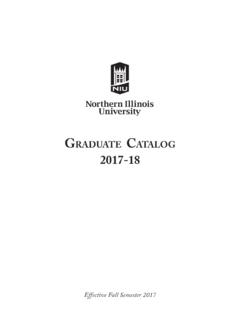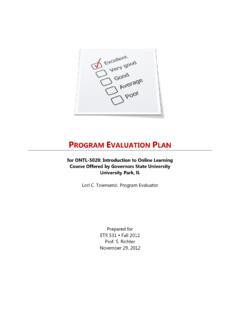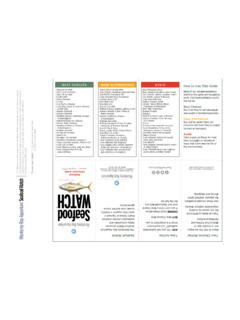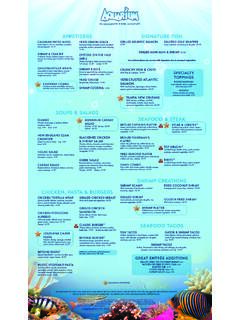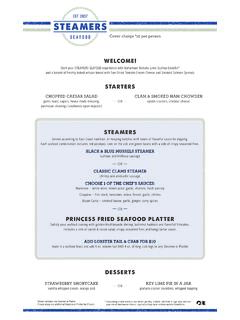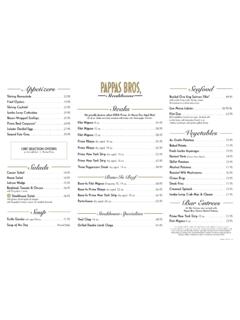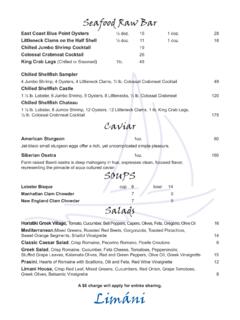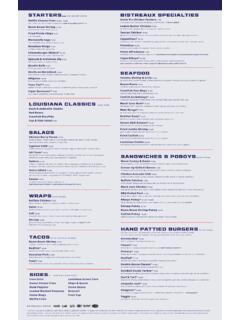Transcription of Southeast Asian Food and Culture
1 Southeast Asian food and [11/16/2009 10:27:27 AM] Southeast Asian food and CulturebyBrent Roman and Susan RussellNorthern Illinois UniversityCONTENTSI. INTRODUCTIONII. OVERVIEW OF food AND CULTUREIII. LESSON PLANIV. REFERENCESI. IntroductionA. Grade: 9th - 12th grade (high school)B. Topic: Southeast Asian food and its influence on cultureC. Scope: This module includes a lesson plan for an academic school week. Four sections: four days, althoughthese may be Goals:1. General objectives:a. Students will become familiar with some of the food of Southeast Students will become familiar with various examples of how Culture has been shaped throughthe influence of food within Southeast Specific objectives:a. Students will learn the basic geography of this Students will participate in an activity to digest the information in the Students will relate the information to their own Culture and daily lives through groupcollaboration and Students will learn to prepare a Southeast Asian meal.
2 E. Materials:1. map of Southeast Asia2. slide projector and slides (or visit the picture database on ) Southeast Asian food and [11/16/2009 10:27:27 AM]3. access to a school kitchen and appropriate ingredients for particular recipesII. Overview of food and Culture in Southeast Asia A. Food1. Statistics: More than 3/4 of the Southeast Asia population is agriculture-based. Twice as much fishis consumed in this region compared to other forms of animal protein, reflecting the long coastlines andriver environments of Southeast Asia. The staple food throughout the region is rice, which has beencultivated for thousands of years. Rice serves as the basic staple food for more than half of the world'spopulation today. 2. General Information: Simple daily meals and elaborate feasts characterize all Southeast Asianculinary cultures. Cooking is economically efficient as people use wok cooking, which requires a lowamount of fuel and makes deep-frying easy.
3 Also, meat and vegetables are typically chopped into smallpieces prior to cooking, which mean that food cooks very quickly. Most food is cooked by quickblanching or stir-frying and steaming. Southeast Asians are concerned with nutrition, economy, andease of preparation as it relates to their food . Due to the close proximity of the borders between countries in Southeast Asia, and to combinedinfluences from India and China that have affected indigenous taste and cooking styles, the ingredientsare similar throughout most of the region while they are nonetheless manipulated by each Culture to suittheir palate and taste. Most often, food is consumed in Southeast Asia on a mat raised off the ground traditionally. Modernhomes may use a table and chairs. Generally, food is eaten at room temperature, as the climate is quitewarm throughout the year. In Asia, there are different styles of eating food . In India and the Middle East, as well as SoutheastAsia, people eat food with their hands.
4 It is a very direct way to experience the texture of the food , andpeople normally wash their hands before and after each meal. Normally, only the right hand is used, sothat one knows to keep it especially clean. Generally, the foods to be eaten are placed on plates in thecenter of the mat or table, and people take food in small portions as they eat. The exception to this pattern is Vietnam, where the influence of China was much stronger thananywhere else in Southeast Asia. Here, each person has chopsticks, and food is served and apportionedonto individual plates or into individual bowls. A similar pattern is found in other Asian countrieswhere Chinese influence was especially strong, , Japan, Tibet, and influence of Western cultures is found not only in the use of tables and chairs in many modernSoutheast Asian households, but also in the use of spoons and forks. Knives are not necessary, sincemeat and vegetables are chopped into smaller portions before cooking or serving.
5 A large spoon is heldin the right hand, while the left hand is used to shovel food into the spoon. 3. Milk-related products: Southeast Asians, unlike cultures in northern and central Asia, do not usemilk in the way that Europeans and Americans do. While bread has become popular as a snack orbreakfast food item in countries that were colonized by European nations, most Southeast Asians do notconsider milk, yogurt, cheese, and other dairy foods to be a popular source of nutrition. Instead, soy-bean milk, soy-bean paste, and soy sauce are alternative food preferences for most people, withevaporated milk and modern-day substitutes commonly used to sweeten coffee or prepare desserts. Coconut milk, as a very different and indigenous product, is widely used as Specific food information: The food consumed in Southeast Asia varies not only by country, but byreligious and ethnic tradition. This diversity makes Southeast Asian food a fascinating, if life-long (!)
6 , Southeast Asian food and [11/16/2009 10:27:27 AM]adventure to people who try to master such cooking. Here are a few themes. Both Indian and Chineseinfluences are present in the foods of Southeast Asia, as well as Western influences Indian cooking has influenced much of Southeast Asia. However, Indian cooking variesthroughout the country and according to ethnic and religious preference. Most know thatMuslims do not eat pork, and that the month of Ramadan (the ninth month of the Muslim lunarcalendar) is a time of fasting for Muslims all over the world. Muslims may neither eat nor drinkduring the daylight hours of this , in contrast, find that cows are sacred and the eating of beef is forbidden. Others,especially of the high caste or from the south of India, are vegetarians. China is much moreeclectic, and the Chinese who follow Taoist traditions believe that food should be combined inways that have medicinal or healing properties. Some foods are "hot", and should be avoided bypregnant women or those with high blood pressure.
7 Examples of hot foods include chili peppersand ginger. Other foods are "cool", such as eggplant, and should be eaten by people who wishto lower their blood pressure. The popularity of wheat in northern China also led to theirdevelopment of noodles as a staple of many dishes. By all of these means, people believe theycan effectively regulate their body processes and , too, are expected to not eat meat, as the killing of any animal is antithetical toBuddhist beliefs. However, many Buddhists do eat meat as well as fish, and this belief tends tobe most closely observed by monks or ascetics rather than by ordinary people originated in India, with the milk and butter from cow raising being included in therecipes. In Southeast Asia, coconut milk was substituted for real milk, with a very differentsubsequent taste to the curries. Noodles are popular throughout Southeast Asia, and reflectChinese as well as Indian influence in the spices and methods of food ways also have had their influence in Southeast Asia.
8 In the Philippines, forexample, Spanish influence is clearly present not only in the languages of the country but intheir love of such dishes as pan de sal (a type of bread), kilawin (marinated raw seafood withchili), paella (a seafood , meat and rice stir fry dish), empanada (a sweet bread), and a variety ofother seasoned meat dishes. Conventional dishes in the Philippines reflect more influence froma blend of Chinese, Spanish, and indigenous Southeast Asian traditions than is found anywhereelse in Southeast Asia. b. Popular meals in Southeast Asia consist of rice, fish, vegetables, fruits, and spices. Curry,"satay" (spiced or marinated meat on a stick that is barbecued), "sour fish soup", noodles, andsoy products are popular. Flavorings that are common include ginger, pepper, chili peppers,onions, garlic, soy sauce, fish sauce, fermented fish paste, turmeric, candlenut, lemon grass,cloves, nutmeg, cinnamon, as well as tamarind and lime (for a sour taste).
9 Coconut milk is oftenused to bind sharp flavors, while palm sugar is used to balance the spices. Unique combinationsof sweet and sour, or hot and sour, hot and sweet, are common in various regions. Fish pasteand prawn paste is spicy-sour, and is popularly consumed with green mangoes, fresh fish, or instews. Fish sauce is used in almost all Southeast Asian curries as well as in various forms ofcooking fish and pork. Popular vegetables are sweet potatoes, maize, taro, tapioca, legumes,blossoms, and the leaves of many green plants. Popular fruits are pineapple, coconut, star fruit,jackfruit, papaya, bananas, rambutan, mangosteen, and the somewhat odorous durian ("king ofthe fruits", according to aficionados). Tea and coffee are abundant throughout the region,although the popular drink with a meal is Highland cuisine. Some might say that cuisine in the highlands of Southeast Asia is a non-sequitur. Foods here tend to be blander and less fancy compared to foods that have longcharacterized lowland civilizations.
10 Typically, meat is boiled in a large vat or roasted. Southeast Asian food and [11/16/2009 10:27:27 AM]However, the highlands of Southeast Asia are quite varied in terms of food preparation, and thebiggest and most popular events of the year focus on ritual feasts. Ritual feasts often are held byaspiring politicians and individuals who wish to raise their status and prestige in thecommunity. This feasting tradition is not new, but centuries old. Politics formerly revolvedaround the reputation of individuals who had sponsored larger feasts than their competitors, ,they had butchered more animals for a large feast and were thus able invite more guests. In thisway, the guests bestowed them with respect and legitimacy, thus leading to a very unique styleof political system wherein authority was tied into food and feeding of one's followersperiodically. Most often, the occasion for feasting was determined by the ritual cycle andreligious belief system.





